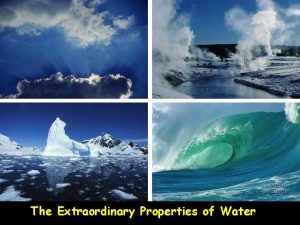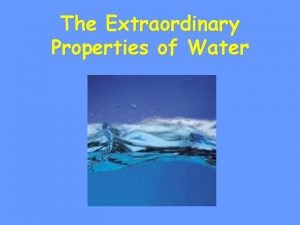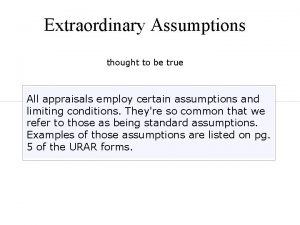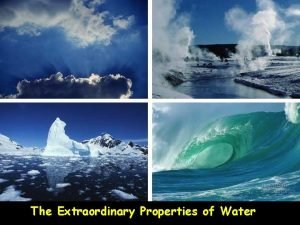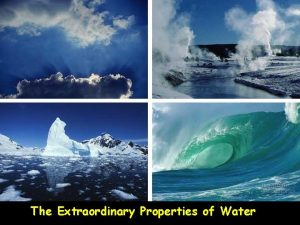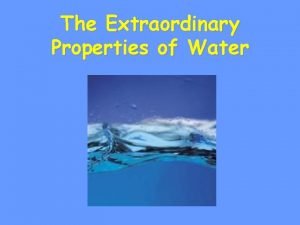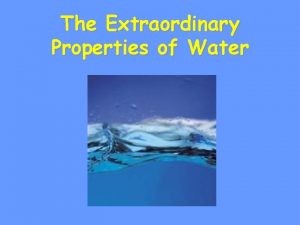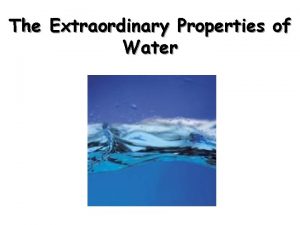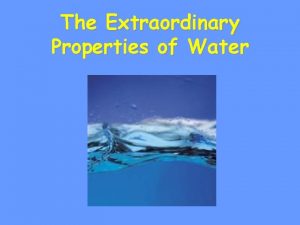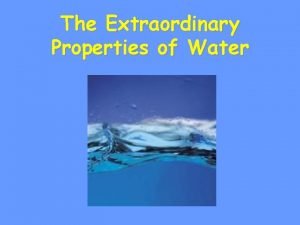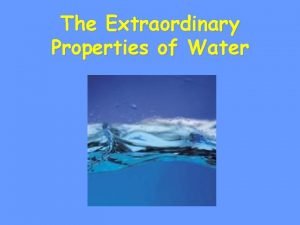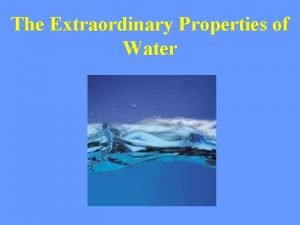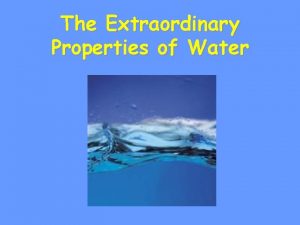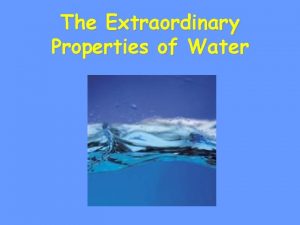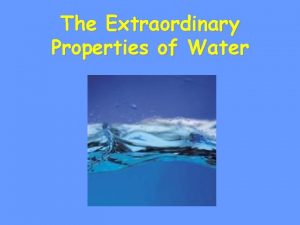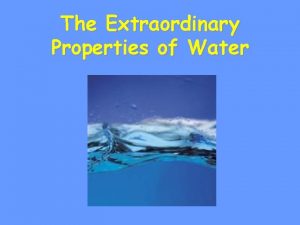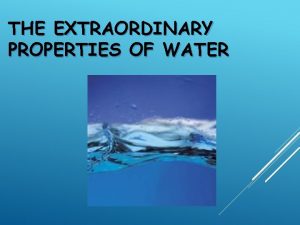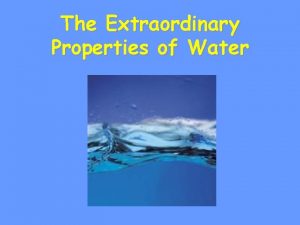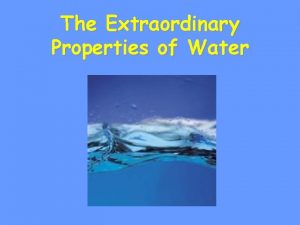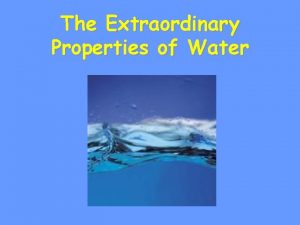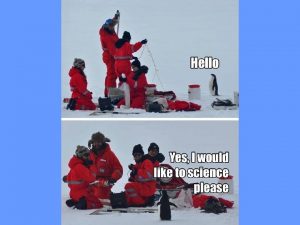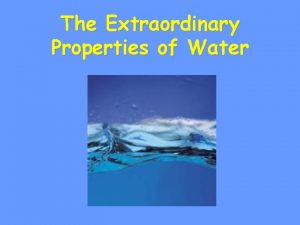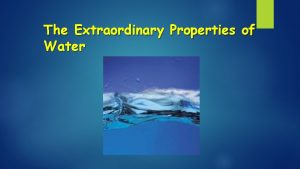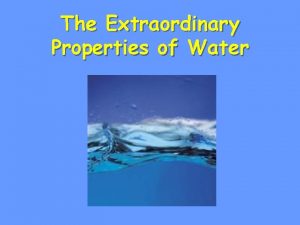The Extraordinary Properties of Water Water A water





































- Slides: 37


The Extraordinary Properties of Water

Water • A water molecule (H 2 O), is made up of three atoms --one oxygen and two hydrogen. H O H

Water is Polar • In each water molecule, the oxygen atom attracts more than its "fair share" of electrons • The oxygen end “acts” negative • The hydrogen end “acts” positive • Causes the water to be POLAR • However, Water is neutral (equal number of e- and p+) --- Zero Net Charge

Hydrogen Bonds Exist Between Water Molecules • Formed between a highly Electronegative atom of a polar molecule and a Hydrogen • One hydrogen bond is weak , but many hydrogen bonds are strong

Interaction Between Water Molecules Negative Oxygen end of one water molecule is attracted to the Positive Hydrogen end of another water molecule to form a HYDROGEN BOND

What are the Properties of Water?

Properties of Water • At sea level, pure water boils at 100 °C and freezes at 0 °C. • The boiling temperature of water decreases at higher elevations (lower atmospheric pressure). • For this reason, an egg will take longer to boil at higher altitudes

Properties of Water • Cohesion

Cohesion • Attraction between particles of the same substance ( why water is attracted to itself) • Results in Surface tension (a measure of the strength of water’s surface) • Produces a surface film on water that allows insects to walk on the surface of water

Cohesion … Helps insects walk across water

Properties of Water • Cohesion • Adhesion

Adhesion • Attraction between two different substances. • Water will make hydrogen bonds with other surfaces such as glass, soil, plant tissues, and cotton. • Capillary action-water molecules will “tow” each other along when in a thin glass tube. • Example: transpiration process which plants and trees remove water from the soil, and paper towels soak up water.

Adhesion Causes Capillary Action Which gives water the ability to “climb” structures

Adhesion Also Causes Water to … Form spheres & hold onto plant leaves Attach to a silken spider web

Why does water form? In a water molecule two hydrogen atoms form single covalent bonds with an oxygen atom. The bonds are formed to create a “stable” molecule. Oxygen needs 2 more electrons to be stable. Hydrogen needs 1 more electron to be stable. *Gives water more structure than other liquids*

Water Activity Sticky Molecule Article Directions: 1. Color 1. All oxygen RED 2. All hydrogen Blue 3. Two Electrons Yellow 2. Cut all circles 3. Glue 1. Oxygen nucleus over center of O 2. Hydrogen nuclei over H 4. Glue oxygen and Hydrogen to paper 5. Place electrons ask teacher confirmation. 6. Glue Electrons 7. Write Article by answering questions

Water Activity Sticky Molecule 1. Article Name the elements found in the water molecule. What is the ratio of hydrogen to oxygen. 2. How does one molecule of water form? What is the name of the bond (label it in your picture) 3. Describe a polar molecule. Also label this in your picture! 4. How do two molecules of water stick together? What is the name of the bond and property? 5. Describe what is happening when water flows down a piece of wet yarn.

Properties of Water • Cohesion • Adhesion • Universal Solvent

Water ……a. k. a the Universal Solvent Water is the solvent of Life! - Because of the polarity water is able to dissolve the many substances. Solute – substance dissolved in a solvent to form a solution Solvent – fluid that dissolves solutes

Solving Dissolving Lab!

Solubility Lab! – ws#6

Solubility Lab! – ws#6

Solubility Lab! – ws#6

Solubility Lab! – ws#6

Properties of Water • Cohesion • Adhesion • High Specific Heat

High Specific Heat • Amount of heat needed to raise or lower 1 g of a substance 1° C. • Water resists temperature change, both for heating and cooling. • Water can absorb or release large amounts of heat energy with little change in actual temperature.

Water holds onto Heat and won’t let it go! • • The amount of heat that a substance can “hold” is called Heat Capacity. Three-fourths of the earth is covered by water. The water serves as a large heat “sink” (or bank) responsible for: 1. Prevention of temperature fluctuations that are outside the range suitable for life. 2. Coastal (Beach) areas having a mild climate 3. A more stable marine (water) environment 28

Properties of Water • Cohesion • Adhesion • High Specific • High Heat of Heat Vaporization

Properties of Water • Cohesion • Adhesion • High Specific Heat • High Heat of Vaporization • Less Dense as a Solid

Water is Less Dense as a Solid • Ice is less dense as a solid than as a liquid (ice floats) • Liquid water has hydrogen bonds that are constantly being broken and reformed. • Frozen water forms a crystal-like lattice whereby molecules are set at fixed distances.

Water is Less Dense as a Solid • Which is ice and which is water?

Water is Less Dense as a Solid Water Ice

Only water is found _______ as a SOLID, LIQUID, and GAS on Earth! While all elements will change states, only some compounds will. Water changes state within a very narrow range, allowing it to snow, rain, and evaporate… all on the same day! 37

Ice is less dense than liquid water! Solids are usually more dense than liquids because their molecules are closer together. Liquids are more dense than gases… but not for water. Water forms a __________ structure which makes ice (solid water) less dense than liquid water. 38

Solid Organized Liquid Gas Disorganized Free Floating

Water “grows” when freezing: 1. This causes potholes on road and weathering of rocks. 2. It prevents water from freezing from the bottom up. Ice forms on the surface first—the freezing of the water releases heat to the water below creating insulation. This makes transitions between seasons less abrupt. 40
 The extraordinary properties of water
The extraordinary properties of water The extraordinary properties of water
The extraordinary properties of water Water and water and water water
Water and water and water water The most extraordinary country to explore
The most extraordinary country to explore Extraordinary life quotes
Extraordinary life quotes Four obsessions of an extraordinary executive summary
Four obsessions of an extraordinary executive summary Extraordinary assumption appraisal
Extraordinary assumption appraisal Creating extraordinary teams
Creating extraordinary teams Connotation of extraordinary
Connotation of extraordinary Guerilla denotation
Guerilla denotation Closing prayer for class
Closing prayer for class Characteristics of extraordinary teachers
Characteristics of extraordinary teachers Intensive vs extensive properties
Intensive vs extensive properties Chemical and physical properties
Chemical and physical properties Hình ảnh bộ gõ cơ thể búng tay
Hình ảnh bộ gõ cơ thể búng tay Frameset trong html5
Frameset trong html5 Bổ thể
Bổ thể Tỉ lệ cơ thể trẻ em
Tỉ lệ cơ thể trẻ em Gấu đi như thế nào
Gấu đi như thế nào Chụp phim tư thế worms-breton
Chụp phim tư thế worms-breton Hát lên người ơi
Hát lên người ơi Các môn thể thao bắt đầu bằng tiếng đua
Các môn thể thao bắt đầu bằng tiếng đua Thế nào là hệ số cao nhất
Thế nào là hệ số cao nhất Các châu lục và đại dương trên thế giới
Các châu lục và đại dương trên thế giới Công thức tiính động năng
Công thức tiính động năng Trời xanh đây là của chúng ta thể thơ
Trời xanh đây là của chúng ta thể thơ Mật thư anh em như thể tay chân
Mật thư anh em như thể tay chân Làm thế nào để 102-1=99
Làm thế nào để 102-1=99 Phản ứng thế ankan
Phản ứng thế ankan Các châu lục và đại dương trên thế giới
Các châu lục và đại dương trên thế giới Thơ thất ngôn tứ tuyệt đường luật
Thơ thất ngôn tứ tuyệt đường luật Quá trình desamine hóa có thể tạo ra
Quá trình desamine hóa có thể tạo ra Một số thể thơ truyền thống
Một số thể thơ truyền thống Cái miệng nó xinh thế
Cái miệng nó xinh thế Vẽ hình chiếu vuông góc của vật thể sau
Vẽ hình chiếu vuông góc của vật thể sau Thế nào là sự mỏi cơ
Thế nào là sự mỏi cơ đặc điểm cơ thể của người tối cổ
đặc điểm cơ thể của người tối cổ V. c c
V. c c
